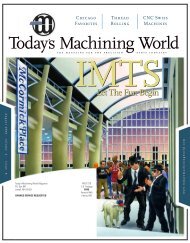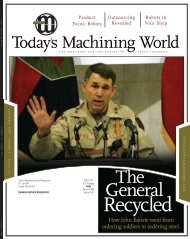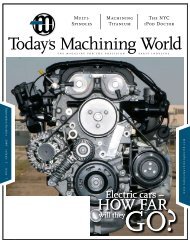A Night at the - Today's Machining World
A Night at the - Today's Machining World
A Night at the - Today's Machining World
You also want an ePaper? Increase the reach of your titles
YUMPU automatically turns print PDFs into web optimized ePapers that Google loves.
one on one<br />
Wh<strong>at</strong> is a typical piece of pit equipment<br />
you’d build in <strong>the</strong> team’s machine shop?<br />
GW: We build all of our pit equipment here. We make timing<br />
stands, fuel rigs, wheel carts. Everything has to be as quick<br />
as it can be, so we try to make everything down to <strong>the</strong> wheel<br />
guns th<strong>at</strong> take <strong>the</strong> nuts off <strong>the</strong> race car. We use air jacks—a<br />
pneum<strong>at</strong>ic jack to lift <strong>the</strong> car. We look <strong>at</strong> every aspect of <strong>the</strong> car<br />
to try to make it go faster or make it lighter.<br />
Wh<strong>at</strong>’s <strong>the</strong> difference between<br />
Formula 1 cars and Indy cars?<br />
GW: The cars look pretty similar but a lot more money is spent<br />
developing Formula 1 cars. Also, <strong>the</strong> rule sets are different<br />
and <strong>the</strong> minimum weight of [Indy] cars changes depending<br />
on <strong>the</strong> track, whe<strong>the</strong>r it’s an oval or road course or super<br />
speedway. [Indy] cars are around 1,600 pounds empty, while<br />
Formula 1 cars are 1,200 pounds. Indy cars have about 650<br />
horsepower, and Formula 1 cars have about 750 horsepower.<br />
A Formula 1 car would not be able to race <strong>at</strong> <strong>the</strong> Indianapolis<br />
500 because <strong>the</strong> parts and pieces on it aren’t designed to take<br />
<strong>the</strong> G-loadings and <strong>the</strong> high speeds.<br />
Is <strong>the</strong>re a lot less contact between cars<br />
in an IndyCar race than a NASCAR race?<br />
GW: In NASCAR, it’s a little easier for you to lean on your<br />
friends than it is in IndyCar. In IndyCar, if you touch wheels,<br />
one of <strong>the</strong>m is going to go flying. In NASCAR, you can<br />
bump a little bit, but <strong>the</strong> idea is th<strong>at</strong> <strong>the</strong> cars are so tweaked<br />
aerodynamically th<strong>at</strong> if you’re rubbing fenders or banging on<br />
somebody, you’re changing your aero, and th<strong>at</strong> car might not<br />
work as well as it was previously.<br />
How much does one Indy car cost?<br />
GW: Basically you can say <strong>the</strong> initial expense is about $375,000<br />
for a rolling car. You add $100,000 worth of electronics. We<br />
lease <strong>the</strong> engines [from Honda], and <strong>the</strong> lease is approxim<strong>at</strong>ely<br />
a million dollars per year per driver. The brakes don’t come on<br />
Interviewed by Noah Graff<br />
Grant Weaver is one of <strong>the</strong> team managers for<br />
Chip Ganassi Racing in Indianapolis. He is in charge of production, purchasing<br />
and prepar<strong>at</strong>ion of subassembly components for Ganassi’s ROLEX GRAND-AM<br />
Racing and IZOD IndyCar Series, both 2010 champion teams.<br />
<strong>the</strong> car and <strong>the</strong> drive shafts don’t come on <strong>the</strong> car. So when<br />
all is said and done and you put a car on <strong>the</strong> racetrack, <strong>the</strong>re’s<br />
about a million dollars rolling around on <strong>the</strong> road.<br />
How important is <strong>the</strong> speed of <strong>the</strong> pit stops?<br />
It seems strange to me th<strong>at</strong> <strong>the</strong> cars actually<br />
stop in <strong>the</strong> middle of a race.<br />
GW: Th<strong>at</strong>’s a rel<strong>at</strong>ive word, “stop.” The driver is never fully<br />
stopped. You’ve got to think about stick and ball sports like<br />
football and baseball. When <strong>the</strong> offense is on <strong>the</strong> field, <strong>the</strong><br />
defense is resting and vice versa. A race car driver’s only<br />
reprieve is during th<strong>at</strong> pit stop. He’s got to be able to put <strong>the</strong><br />
car on an exact spot in his pit box so th<strong>at</strong> his guys can perform<br />
<strong>the</strong>ir tasks without having to move. Right now it takes less<br />
than six seconds to fuel an Indy car during <strong>the</strong> pit stop with<br />
22 gallons of ethanol, while changing all four tires <strong>at</strong> <strong>the</strong> same<br />
time.<br />
How has safety for Indy cars<br />
improved over <strong>the</strong> years?<br />
GW: The cockpit area of <strong>the</strong> car is phenomenally safer than<br />
just a few years ago. The se<strong>at</strong>s [are safer], [<strong>the</strong> helmets] have a<br />
HANS device to keep <strong>the</strong> driver’s head realistically <strong>at</strong>tached to<br />
his body. There are different se<strong>at</strong>belts and special padding th<strong>at</strong><br />
go around <strong>the</strong> cockpit. All help contribute to <strong>the</strong> driver being<br />
able to walk away from a horrendous crash.<br />
Wh<strong>at</strong> are your favorite racing movies?<br />
GW: I have a couple favorite movies. Grand Prix with James<br />
Garner from around 1966, which went during <strong>the</strong> Formula 1<br />
season th<strong>at</strong> year. Le Mans with Steve McQueen, which played<br />
a lot around <strong>the</strong> Le Mans 24-hour race of 1970. And, not so<br />
much for <strong>the</strong> drama part, but Paul Newman in Winning, which<br />
is from <strong>the</strong> 1960s and also focuses around <strong>the</strong> Indianapolis<br />
500. They haven’t made a lot of good movies about racing<br />
since <strong>the</strong>n. Talladega <strong>Night</strong>s is <strong>the</strong> worse movie I’ve ever seen in<br />
my life. Didn’t think much of Days of Thunder ei<strong>the</strong>r.<br />
November/December 2010 37<br />
one on one








